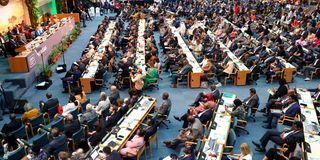Premium
UNEA-6 resolutions: The key points and implications

President William Ruto delivering his remarks at UNEP headquarters in Nairobi on February 29, 2024 during the sixth session of the United Nations Environment Assembly (UNEA-6).
What you need to know:
- This year, there were 19 resolutions under consideration, but only 15 made it to the final document passed during the Assembly.
- Here is a breakdown of each resolution and its implications for countries worldwide.
After a week of negotiations at the sixth session of the United Nations Environment Assembly (UNEA-6), delegates left with resolutions and decisions to guide countries on critical environmental issues. This year, there were 19 resolutions under consideration, but only 15 made it to the final document passed during the Assembly. Two decisions and a ministerial declaration were also passed. Here is a breakdown of each resolution and its implications for countries worldwide.
- Environmental aspects of minerals and metals
Negotiations for this resolution started in 2019 at UNEA-4, where the main discussion was mineral resource governance. Progress was shared at UNEA-5, and this year, countries agreed on the new aspects of the resolution.
The final draft decision now encourages countries to develop regulations to promote sustainable consumption and production of metals and minerals. They must ensure a complete cycle for mineral management as guided in the 2030 Agenda for Sustainable Development. The agenda aims to reduce any arising negative impacts of minerals and metals on the environment, society and economy.

Haitian Prime Minister Ariel Henry(left),President William Ruto(centre), and United Nations Environment Program (UNEP) Executive Director Inger Andersen after attending the 6th Session of the United Nations Environment Assembly (UNEA) at the United Nations Environment Program (UNEP) Headquarters in Nairobi on February 29, 2024.
- Circularity of a resilient, low-carbon sugar cane agro-industry
This resolution was tabled in 2019 but concluded this year. With the knowledge that sugarcane is farmed in some 80 countries worldwide, including Kenya, negotiators acknowledged that climate change will grossly affect the industry. During the 28th Conference of the Parties to the United Nations Framework Convention on Climate Change. (COP28) in Dubai last year, countries launched the International Alliance for the Circularity of a Resilient and Low-carbon Sugar Cane agro-industry. This helped propel this resolution to fruition this year.
- Amendments to the Instrument for the Establishment of the Restructured Global Environment Facility
This resolution will ensure that the United Nations Environment Programme (Unep) headquartered in Nairobi, will have a stronger mandate in implementing environmental policies under the Global Environment Facility. The facility will ensure inclusivity, transparency, accountability and responsiveness for the projects and programmes under it by ensuring eligibility for] financing global projects is followed to the letter.
- Enhancing the role and viability of regional forums of environment ministers and Unep regional offices in achieving multilateral cooperation in tackling environmental challenges
Its objective is to encourage discussion and collaboration among nations to address environmental challenges within their territories. The outcome of this effort will be reviewed during the next UNEA in 2026, where a stocktake will be conducted to assess how countries have incorporated regional forums and environmental authorities in their efforts.
- Promoting synergies, cooperation or collaboration for national implementation of multilateral environmental agreements and other relevant environmental instruments
A recently released report, Global Resources Outlook 2024 during the UNEA-6 event showed that humans are using up available resources at an unsustainable rate. It highlights the need for equitable resource-sharing among individuals and nations. To achieve this, countries must improve their knowledge and understanding of the potential benefits of collaboration. This can be accomplished by intensifying efforts to gather and share best practices and promoting information exchange.
- Foster national action to address global environmental challenges through increased cooperation between the UNEA, the Unep and multilateral environmental agreements.
After a resolution has been passed by the UNEA, the responsibility of implementing the decisions usually falls on individual countries. While some countries may act promptly, others may take longer to implement the decisions. This resolution encourages all countries to act swiftly and efficiently when complying with multilateral environmental agreements.
- Combating sand and dust storms
During the closing plenary, UNEA-6 Leila Benali stated that sand and dust storms were deadly phenomena that often go unnoticed. Therefore, it is crucial to bring awareness to this issue. Sand and dust storms have been increasing globally, with approximately two billion tons of sand and dust entering the atmosphere each year, according to a report by the United Nations Convention to Combat Desertification (UNCCD). The resolution highlights Africa and Asia as the most affected regions, particularly in arid, semi-arid, and dry sub-regions. The resolution proposes coordinated action to address this challenge and potentially reduce its impact.
- Promoting sustainable lifestyles
This resolution demands that countries implement it at the community level, which requires a change in current standards of living. It must be included in the existing program known as the One Planet Network Programme on Sustainable Lifestyles and Education. Unep will need to provide resources to countries, especially for the educational skills necessary to make this shift.
- Sound management of chemicals and waste
Many countries have been raising concerns about the issue of pollution, which has been causing negative impacts on people's health. Despite being an existing problem, it has been largely ignored. To address this, a resolution was passed by the World Health Assembly last year, which calls for a discussion during the United Nations General Assembly (UNGA) to promote a Global Framework on Chemicals. This resolution aims to manage and tackle pollution more effectively.

President of UN General Assembly Dennis Francis addressing journalists at UNEP headquarters in Nairobi on February 29, 2024 during the sixth session of the United Nations Environment Assembly (UNEA-6).
- Promote regional cooperation on air pollution to improve air quality globally
There are regulations to address air pollution, but there is still a need to enhance air quality further. The latest resolution acknowledges that air pollution not only affects individuals but also leads to the loss of biodiversity. The Assembly recognises that addressing air pollution would result in numerous benefits. Additionally, taking care of air quality could positively impact climate change.
- Manage highly hazardous pesticides
This resolution supports the one passed by the previous UN General Assembly and the one from last year’s World Health Assembly. It highlights the dangers of leaving highly hazardous pesticides unmanaged, which can put people at risk of harm. Therefore, countries are urged to take intentional steps to reduce associated risks. They are also encouraged to conduct studies that can help minimise damage from such pesticides or find alternative and less harmful sources.
- Environmental assistance and recovery in areas affected by armed conflict
Despite the triple planetary crisis that the world is facing, other crises, such as war, continue to disrupt everyday life. In areas affected by armed conflict, people tend to focus solely on the war and overlook other underlying issues, such as the environment. This resolution aims to address this by promoting a comprehensive and sustainable approach to managing the challenges faced by conflict-affected regions.
- Strengthening ocean efforts to tackle climate change, marine biodiversity loss and pollution
There is a growing concern about the health of oceans around the world. Studies conducted by the Intergovernmental Panel on Climate Change (IPCC) have revealed that climate change significantly impacts the ocean and that the situation may worsen as temperatures continue to rise. To address this issue, several agreements and strategies have been put forward, including reducing greenhouse gas emissions from ships.
- Effective and inclusive solutions for strengthening water policies to achieve sustainable development in the context of climate change, biodiversity loss and pollution.
Water is a resource that has often caused conflicts between different countries and communities, as it transcends boundaries, and no single entity can claim ownership of it. Despite this, the world must continue to work towards achieving sustainable development goals related to water. During a recent meeting, delegates expressed concern about the dwindling quantity and quality of water resources worldwide. They encouraged countries to dialogue about collaborating on water-related issues, including local and indigenous knowledge. The progress made on this critical issue will be discussed at the next Assembly.
Strengthening international efforts to combat desertification and land degradation, restore degraded land, promote land conservation and sustainable land management, contribute to land degradation neutrality and enhance drought resilience
Climate change has led to an increase in desertification. However, land degradation is mainly caused by changes in land use. Notably, a large portion of the earth's land is arid, semi-arid, and dry sub-humid. Restoring these lands can help create a more sustainable economy for those who rely on them. This approach integrates various factors and promotes a holistic approach to land management.





